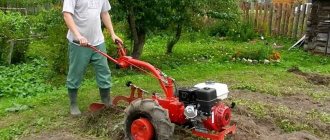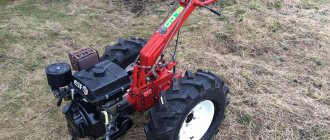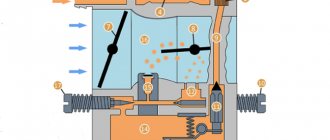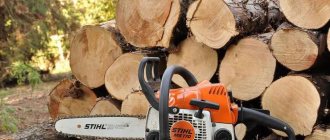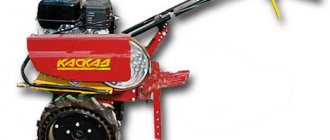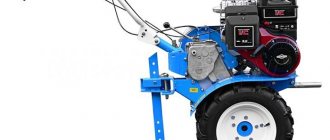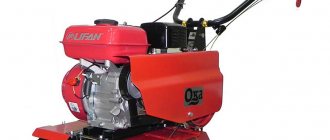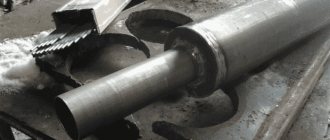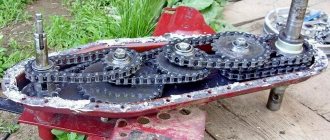Why does the walk-behind tractor stall under load?
A fairly common problem is that the equipment stalls after 5 minutes of operation. Often the reason is a fuel supply failure and ignition problems. If the equipment stalls during operation, you need to check how well the fuel is supplied:
- The candle is taken out and examined. It is overdried - this indicates a lack of fuel;
- There must be enough fuel in the gas tank for the normal functioning of the machine;
- The condition of the fuel valve is inspected. It may simply be blocked. Sometimes it is enough to open it for further use of the unit.
The walk-behind tractor starts and stalls if there is a problem with the ignition. First you need to check the spark plugs. Wet elements indicate breakdown. It is necessary to re-adjust the ignition system of the equipment.
Resetting is done as follows:
- The cover is removed, which protects the parts of the ignition system;
- The engine flywheel rotates until the contacts in the magneto open;
- A special feeler gauge measures the gap from the “anvil” to the “hammer”;
- The flywheel rotates until the piston is compressed. The latter must reach its peak;
- The flywheel turns again until a characteristic knocking sound is heard, which will indicate the operation of the overrunning clutch;
- The flywheel turns in the other direction until the mark of this element coincides with the mark on the body of the unit;
- The gap from the interrupting contact to the cam is set to 0.3 millimeters;
- The cam is fixed with a screw, which is located above the element, and a protective cover is installed in the equipment body.
If the above steps are performed correctly, the walk-behind tractor will not stall under load. When tilted, equipment may stall if there is not enough fuel in the gas tank. The unit must be installed straight and the starter cable removed. If the engine starts, you need to fill the tank with fuel.
Causes of breakdowns
There are a large number of different reasons why a motor fails. Repair of motor cultivators can be carried out at the following points:
- Unstable work.
- The silencer fires.
- The engine stalls under load.
- The engine stalls when starting.
In Moscow there are a large number of companies that repair equipment. Services can be expensive, so many people do the work themselves.
Why does it stall under load?
In most cases, the engine stalls under load due to problems in the fuel supply and ignition system. Fuel system faults can be checked as follows:
- The spark plugs are unscrewed for visual inspection. If the working part is too dry, then there is a possibility of insufficient fuel in the system.
- If the fuel level in the gas tank is too low, shaking may prevent fuel from flowing into the engine.
- The technical condition of the fuel tap is inspected. In some cases, it may be slightly blocked and the engine stalls due to insufficient fuel supply.
The engine of a walk-behind tractor may stall due to incorrect settings of the ignition system.
Too high humidity on the surface of the spark plug indicates a malfunction of the entire fuel system.
Re-tuning is carried out according to the following algorithm:
- The cover is removed, which protects the main parts of the system.
- The flywheel rotates until the contacts open.
- A special probe is used to check the resulting gap.
- The flywheel rotates until the piston is fully compressed. The load is applied until the characteristic sound of the overrunning clutch appears.
- The flywheel is turned in the opposite direction until the marks coincide.
- The gap from the interrupting contact to the cam is set to 0.3 mm.
- The cam position is fixed.
The above procedure solves the problem of the situation where the engine stalls when a load is applied.
Why does it work intermittently?
The installed engine may operate intermittently. The reasons are as follows:
- Using bad fuel. Long-term operation with such a problem may cause a malfunction.
- The equipment operates jerkily if the engine is not fully warmed up. The solution to the problem is to stop the procedure, after which the structure should cool down, the walk-behind tractor turns on and warms up at idle for several minutes.
- The engine may not pull over if the filter elements are clogged.
In some cases, the cable is adjusted to change the amount of fuel supplied to the internal combustion engine.
Why does it shoot at the silencer?
Many problems arise when a silencer fires. A problem can only be solved if it is precisely defined. The silencer fires in the following cases:
- Too much oil in the fuel.
- The ignition is set incorrectly.
- The fuel is of poor quality and does not burn completely in the cylinder block.
Repair problems can only arise if the fuel does not burn completely.
Why does it start and stall?
The walk-behind tractor can start and stall almost immediately. The problem is that the ignition is set incorrectly; to solve it, the spark plug is cleaned and the wiring integrity is checked.
An important element of the fuel system is the carburetor, which mixes fuel with air in the required proportions. Its clogging can cause improper operation; repair involves disassembly and thorough cleaning. Insufficient revolutions indicate a lack of gasoline.
Some models of cultivators do not develop speed if the gearbox breaks down. This is indicated by extraneous sounds emanating from the installed gearbox. The malfunction is eliminated by replacing the oil and worn elements.
Why does the walk-behind tractor work intermittently?
There are other faults that are worth considering:
- The walk-behind tractor engine is running backwards. The reason is often the use of bad fuel. It will not be enough to replace the fuel. The pump and fuel supply hoses are washed;
- The equipment works in jerks. The engine does not warm up completely. You need to turn off the engine and wait for it to cool completely. Then restart it and warm it up for at least ten minutes;
- The engine does not pull, therefore the engine power decreases. The filter system is checked and cleaned. The problem can be caused by wear of the ignition magneto. In this case, the part is replaced.
Owners of both gasoline and diesel vehicles may encounter such problems. Regardless of the specifics of the breakdown, you must urgently stop using the unit and start fixing the problem.
Preparing for launch
The sequence is simple:
- The gear shift lever sets the speed to neutral. It can be checked using the indicator or by simply rolling the walk-behind tractor - in neutral it rolls easily, without rotating the engine.
- The air cleaner damper is placed in the closed position (indicated on the housing near the damper lever).
- The fuel supply valve opens.
- The “Start” button is pressed or fixed on the handle (from the model).
- The recoil starter handle is pulled until the ratchet engages. With a smooth jerk (or several) the internal combustion engine starts.
- After starting, the air cleaner flap opens.
Nuances - if a particular internal combustion engine operates unstably at idle, the start is carried out with the gas handle depressed (the throttle valve is slightly open, the gas is a third or half).
You can find out in detail how to properly start a walk-behind tractor in the video:
When starting a hot engine, the air cleaner damper is not closed at all. There are no “choke” buttons or manual fuel pumping on the carburetor in four-stroke engines. The fuel-air mixture begins to flow (sucked) into the combustion chamber during rotation from the starter without preliminary pumping, which is used on almost all two-stroke single-piston internal combustion engines.
Why does the walk-behind tractor shoot into the muffler?
Sometimes the operation of equipment is accompanied by unusual sounds from the muffler.
The walk-behind tractor smokes and stalls. To eliminate such a malfunction, it is necessary to first determine what caused it. Such problems may occur in the following cases:
- Excess motor oil in fuel. The remaining fuel is drained, the fuel pump and hose system are washed, and new fuel is added;
- Incorrectly set ignition. It is necessary to check how correctly the gap between the electrodes is set;
- The fuel in the engine cylinder does not burn completely. In this case, it is necessary to disassemble the piston system, thoroughly wash and dry the cylinder, and adjust the carburetor.
In the above cases, it is not difficult to repair walk-behind tractors yourself. It is important to strictly adhere to the algorithm of actions.
Why does the walk-behind tractor start and stall?
If the equipment starts and immediately stalls, this may indicate the following problems:
- There may be a large distance between the electrodes, problems with contacts in the electronics, or the spark plug may be dirty. First, the candle is cleaned. Then the integrity of the wires is checked. The normal distance between the electrodes is set;
- The carburetor may become dirty, too little fuel is supplied. Sometimes it is necessary to change the fuel and reduce the amount of oil. The carburetor is dismantled, disassembled and thoroughly cleaned;
- If the unit does not pick up speed, this indicates a lack of fuel. Gasoline may simply spill. The defect must be eliminated or the fuel tank replaced;
- The walk-behind tractor does not develop speed when the gearbox breaks down. This is indicated by the presence of extraneous sound from the gearbox. The malfunction can be eliminated by replacing the oil that lubricates the components.
Preparatory stage
So, you are the owner of a new walk-behind tractor for caring for your vegetable garden, orchard, and even your personal plot. The first thing to start with is checking the oil level. Even if you are sure that there is enough of it there or the store assured you that it is filled in full, you still need to check. If there is not enough oil, you can simply ruin the engine. Also, the car may not start if the oil was filled a long time ago and has already deteriorated. Some engine models, such as Subaru or Lon Chin, have a special sensor that shows exactly how much oil is in your vehicle.
After this, you need to add fuel. In the operating instructions you will find information about which gasoline is suitable for your model of walk-behind tractor. You can also check this information with sellers. Another important point concerns two-stroke engines, where gasoline must be diluted with oil in a certain proportion.
Why does a walk-behind tractor engine have difficulty starting when hot?
The equipment may stall when heated.
This problem can be resolved relatively easily. This is often caused by excess air being supplied to the carburetor. It is mixed with gasoline and motor oil and acts as a carburetor coolant. So the temperature of the latter is much lower than the temperature of the walk-behind tractor engine. To fix the problem, you need to follow a certain algorithm. It is important to start the engine. To do this, perform the following steps:
- When starting the engine, the throttle trigger is squeezed halfway;
- You should not regularly press the gas trigger, as this may cause the engine to flood;
- After starting the engine with the throttle trigger pressed halfway, you need to throttle it thoroughly. Afterwards you can continue working.
Simple actions will prevent an increase in the load on a heated engine; the main elements and systems are not subject to increased wear. The listed methods will allow you to eliminate any malfunctions with the unit. They are equally effective for owners of the following brands: Agro, Honda, Neva, Cascade.
The walk-behind tractor starts and stalls, does not develop speed, malfunctions, repairs
The “heart” of any gasoline-powered vehicle is the engine. Walk-behind tractors are no exception to this. Their motor part creates a working stroke, power potential, and declared productivity, which together make it possible to perform certain agricultural operations.
But often it is this working node that is the most vulnerable. Low-quality fuel, severe overloads, lack of regular diagnostics and many other reasons cause serious malfunctions, the timely detection and repair of which will determine its further performance. This article will be devoted to what types of breakdowns are most often characteristic of walk-behind tractor engines, and which ones can be diagnosed and fixed at home.
The walk-behind tractor starts and stalls: causes of malfunction and mechanisms for eliminating them
Owners of either brand new or used motor cultivators are not insured against a situation where the walk-behind tractor starts but immediately stalls at idle.
It can be caused by a number of factors:
- problems in the ignition system:
- loose or broken electrical contacts;
- spark plug malfunction. They can be installed only after unscrewing and external inspection. If the candle:
- dry - the cause of the malfunction lies in the carburetor, where gasoline is not supplied. It may occur due to clogging of its filter or a separate jet;
- wet - the engine does not develop speed due to an excess of fuel;
- covered with soot - the fact of its failure, which may result in the failure of an ignition spark to form. Testing with electrodes will help you finally verify this;
- after replacing or cleaning the spark plug, the electronics are examined - the integrity of the connections and the wires themselves, which may need repair due to strong vibration;
- shortage or poor quality of fuel . Often the engine does not gain speed due to an incorrectly prepared fuel mixture or debris in the carburetor. In this case, the repair begins with removing it from the walk-behind tractor body and cleaning it from dirt particles. At the same time, they change the fuel, after draining the old one and washing the fuel tank and supply hoses.
- Another reason that the walk-behind tractor starts up and immediately stalls, related to gasoline, may be depressurization of the gas tank itself. Very often this is observed after a long period of inactivity (for example, after winter), when the walk-behind tractor has not been used for a long time and has been stored with gross violations. After repairing or replacing the entire fuel tank, the functionality of the device is usually restored;
- cool weather, which often causes diesel equipment to stall. Therefore, in early spring, experts advise turning on the walk-behind tractor only after pouring hot water into the radiator;
- gearbox malfunction. The fact that the cultivator does not develop speed and stalls at idle is indicated by a characteristic knocking noise from the gearbox, which occurs against the background of a lack of lubricant.
Engine system malfunctions during startup
If, when checking the spark plugs, they turn out to be wet, i.e. fuel flows normally, but the engine does not start, the problem may be the following:
- there is a characteristic carbon deposit on the electrodes of the spark plugs (it is necessary to clean the spark plugs with emery, after which they should be washed with gasoline and dried);
- the gap between the electrodes does not correspond to those specified by the manufacturer in the engine operating manual (the gap is adjusted by bending the side electrode to the required dimensions);
- the insulators of the spark plugs or high-voltage electrical wiring are damaged (faulty spark plugs and wiring must be replaced);
- the STOP button is shorted to ground (for normal engine starting, the short circuit must be eliminated);
- the contacts in the spark plug brackets are broken (the contacts should be put in order);
- the gap between the magnetic shoe and the starter does not correspond to the standard value (the gap needs to be adjusted);
- Defects were detected on the stator of the ignition system (the stator must be replaced).
- Air leaks through carburetor seals, spark plugs, plug and cylinder heads, as well as carburetor and engine cylinder connections.
If depressurization of connections is detected, it is necessary to tighten the mounting bolts, tighten the spark plugs and check the integrity of the gaskets between the spark plug heads and the cylinders.
- Incomplete closing of the carburetor air damper.
To eliminate this problem, it is necessary to ensure free movement of the damper by monitoring the quality of the drive. If jams are detected, they must be eliminated.
Compression failure and carburetor problems
It happens that the launch is carried out, but the process is significantly difficult. At the same time, the engine of the walk-behind tractor is extremely unstable and cannot develop sufficient power for normal operation.
The reason for this may be loss of compression, which can be identified by:
- carbon deposits on the working surfaces of valves, as well as cylinder block seats;
- intake valve deformation;
- wear of piston rings.
In order to restore compression, you must:
- Check the technical condition of the engine gas distribution mechanism, clean the parts contaminated with carbon deposits, and if there are defects, replace them.
- Check the condition of the piston rings and replace faulty components.
If during engine operation black smoke comes out of the muffler, and excess oil is detected on the electrodes of the spark plugs or they themselves are covered with soot, this means that:
- a supersaturated fuel mixture is supplied to the carburetor;
- the sealing of the carburetor fuel valve is broken;
- the piston oil ring is worn out;
- The air filter is clogged.
To resolve this issue you should:
- adjust the carburetor;
- replace a leaky valve;
- replace worn piston rings;
- Clean or replace the faulty air filter.
If, when the engine is running, light smoke comes out of the muffler, and the electrodes of the spark plugs are dry and covered with a white coating, this means that a lean fuel mixture is entering the carburetor. This problem is eliminated by adjusting the carburetor.
Why does the walk-behind tractor work intermittently?
Despite the wear resistance of the motor part, it is not protected from malfunctions. The appearance of extraneous noises, jerks, and pauses in its operation are the main evidence that it needs urgent diagnosis and repair.
If the cultivator periodically stalls and does not develop speed, this may be due to:
- insufficient heating of the motor unit, which operates jerkily. A diesel cultivator, like a gasoline cultivator, requires at least 10 minutes to warm up;
- a broken starter cable, which is replaced with a new one instead of repair;
- loosening the screw ties between the starter and the motor;
- malfunctions of the ratchet, which prevents the normal operation of the starting unit;
- failure of the cylinder and pistons;
- low-quality gasoline, which is why the engine does not develop speed, does not develop speed and backfires. The situation can be corrected without repairs: after washing the fuel tank and hoses, they simply switch to new fuel.
It also happens that the engine “does not pull”, which can be seen in the overall productivity of the device.
This can be caused by:
- clogging of filtration components;
- ignition magneto failure.
Why does the walk-behind tractor stall under load?
The problem when the walk-behind tractor operates with periodic stalls and does not develop speed is perhaps the most common among gasoline and diesel units. If the walk-behind tractor starts and stalls, the main reasons for this phenomenon should be sought in the fuel supply and ignition systems, malfunctions of which may appear after 5 minutes of operation.
If the walk-behind tractor does not develop speed and stalls spontaneously, you need to check:
- aerofilter - if it becomes clogged, its surface is cleaned, washed or blown with a vacuum cleaner.
- quality of refueled fuel;
- ignition system - its diagnosis begins with a spark plug, the external condition of which is used to judge the functionality of the ignition.
In addition to the spark plug, other ignition failures of the walk-behind tractor are:
- incorrect gap between electrodes;
- mechanical damage to the electrical circuit;
- unadjusted angle between the magnetic part and the coil.
Repairing them yourself is allowed if this is provided for in the user manual for a specific walk-behind tractor model;
- muffler - the engine stalls during operation and does not develop speed due to a clogged muffler. To free it from combustion products, it is soaked in water with detergents and, after washing, dried;
- carburetor, the settings of which may be incorrect;
- cylinder-piston parts, due to which the engine does not develop speed under load. This can only be checked with a compression gauge.
It also happens that the cultivator suddenly stalls when tilted in both directions or only to the left or right. Most often this occurs due to insufficient oil level. At the moment of tilt, the lubricant remaining sensor in the crankcase may be triggered, which automatically blocks the motor.
Other common engine starting problems
What to do if the walk-behind tractor engine operates intermittently and does not develop the required power? There may be several reasons for this behavior:
- Air filter clogged.
Air does not enter the carburetor, which means the fuel does not burn well - the filter will have to be cleaned or replaced.
Residues of fuel, as well as the products of its combustion, form a thick coating on the internal walls of the muffler, which must be removed.
In this case, the assembly will have to be removed, disassembled and all its components properly cleaned. After this, the carburetor must be assembled and adjusted correctly.
- Wear of the cylinder-piston group.
Temperature and high loads take their toll, and even the strongest metal wears out and deforms over time. Such parts should be replaced immediately, otherwise you may pay for it with irreparable damage to the engine itself.
- Broken ratchet housing or ratchet
The presence of this problem is indicated by the absence of crankshaft movement when starting the engine. To replace the clutch housing and ratchet, you will have to completely disassemble the starting unit.
- Loosening the screws securing the starter housing to the engine housing.
If the starter cord does not return to its original position, the starter needs to be adjusted. To do this, the screws are loosened, and the position of the knot is set by hand so as to ensure normal return of the cord.
A fairly common reason for the starter cord not returning is the failure of the starter spring - it will have to be replaced.
Competent maintenance of its main units and components significantly increases the service life of any equipment. Efficiency of replacement of worn-out spare parts is also of great importance. Therefore, if the slightest failures or malfunctions occur, they should be addressed immediately - in the end, this will prevent much more serious and expensive problems.
Why does the walk-behind tractor shoot into the muffler?
Often, if the engine system malfunctions, the walk-behind tractor not only does not develop speed, but also produces obvious, ear-piercing sounds emanating from the muffler. After this, it smokes and stalls, which clearly causes concern to users.
The cause of this problem may be:
- excessive intake of oil into gasoline or diesel, due to which its combustion is accompanied by the release of unnaturally acrid smoke. In this case, the repair consists only of cleaning the fuel system and refueling with high-quality fuel;
- failure to adjust the ignition or failure of its components - first of all, pay attention to the gap between the electrodes and, if necessary, set it in accordance with the operating instructions;
- incomplete combustion of fuel in the engine cylinder. In this case, repair of the walk-behind tractor engine begins with disassembling the entire cylinder-piston group, which is cleaned and checked for defects. It must be remembered that after such manipulations it will not be superfluous to reconfigure the carburetor.
How to make a muffler for a walk-behind tractor with your own hands?
If you decide to make a muffler for your walk-behind tractor yourself due to a breakdown or poor quality of a factory part, first of all you need to acquire a minimum set of tools. To work you will need:
Afterwards, you should carefully familiarize yourself with the design of the factory muffler in order to understand the design itself and note the weak points of the part. Typically, such vulnerable points are the flange mount, which is made of low-quality metal or is of insufficient thickness, expansion chamber partitions, narrow pipes that impede the exit of exhaust gases, reducing the productivity of the entire walk-behind tractor.
The actual stages of manufacturing and assembling a new muffler should be performed in the following sequence:
- Flange mounting. Typically, the thickness of the workpiece is selected around 8-12 mm, but the thicker the better. Especially if the future design provides for the muffler to be directed upward.
- Expansion chamber. In fact, this is the main part in the muffler. It looks like a kind of thickening with partitions inside. It is these partitions that reduce the flow rate of exhaust gases and reduce noise during operation of the walk-behind tractor. To make a quiet muffler on a walk-behind tractor, you need to place at least 3 partitions in the expansion chamber. Too many of these partitions, of course, will help make your walk-behind tractor quiet, but this will interfere with the operation of the engine.
- Exhaust pipe. This part must have sufficiently thick walls and at the same time not be too heavy so as not to destroy the entire structure. The diameter of the pipe should be selected to be the same diameter as the engine exhaust pipe - this will ensure smooth operation of the entire fuel system of the walk-behind tractor.
Below is a detailed drawing for making your own muffler for a walk-behind tractor. We invite you to watch a video about what a self-made high-quality muffler for a Neva walk-behind tractor looks like:
What to do if the walk-behind tractor engine does not start well when hot?
If the walk-behind tractor does not develop speed when hot, fault diagnosis is carried out in the following sequence:
- after several unsuccessful startup attempts, the spark plug is examined as described above. If possible, it is better to immediately replace it with a new one in order to completely eliminate questions on this point;
- check the compression and vacuum level in the gas tank;
- in a dark room, see if the wiring is sparking;
- make sure that when heated, a spark is definitely formed. In addition to the spark plug, a faulty ignition coil can also prevent sparking.
Other causes of malfunction include:
- lack or incorrect filling of oil, due to which the triggered oil level sensor blocks the operation of the engine part;
- failure of the valve in the fuel tank, which is supposed to maintain gasoline pressure. As a result, its liquid contents do not flow into the carburetor.
Repairing walk-behind tractors, and especially their power plant, is a responsible matter that requires literacy and good dexterity. This applies not only to domestic favorites - the Neva, Cascade, Agro walk-behind tractors, but also imported ones, for example, Honda. But this does not mean that repairing them yourself is impossible. Having a minimum amount of knowledge and following our recommendations above, you can eliminate any malfunctions at home.
Carburetor in a motorcycle
It happens that the motorcycle shoots into the muffler and carburetor - this is often found on domestic Urals and imported choppers with a large cylinder capacity. The problem is a clogged air-fuel mixture at the inlet. To eliminate it, it is worth changing the filters and sealing gaskets, and also checking how tightly the pipes fit to the inlet fittings and whether there are any large cracks in them.
Very often, popping noises appear after replacing the muffler with a non-standard one or cutting holes in it to eliminate resistance to escaping exhaust gases. Particularly unpleasant sounds appear when installing a “direct flow”.
The reason is the creation of a strong vacuum, which leads to a lean air-fuel mixture.
Powerful imported motorcycles often use an exhaust gas afterburning system, which reduces their toxicity - after removing the standard muffler, its operation becomes clearly audible. To eliminate shots after changing the silencer, you must:
- Reconfigure the carburetor or reflash the control unit.
- Install filters with a different capacity.
- Disable the exhaust gas afterburning system.
On sports motorcycles whose engines run at high speeds, the problem with shots may be related to the speed limiter or crankshaft speed limiter. When a certain indicator is reached, the fuel supply may remain unchanged for some time, while the number of flares is reduced.
Accordingly, a huge amount of gasoline enters the muffler, which explodes with a jerky sound, forming a “machine gun burst.” It can be heard especially well when releasing the gas after active acceleration.
It is impossible to eliminate such a problem without reducing the life of the engine - you have to change your driving style so as not to irritate yourself and others with unpleasant loud bangs.
Repair: why the walk-behind tractor stalls under load, shoots into the muffler, works intermittently, and more
A walk-behind tractor is one of the most useful household units. Even a simple and not particularly powerful machine can make caring for your garden and surrounding area much easier. At the same time, a walk-behind tractor is a piece of equipment that tends to break down. Let's look at the most common breakdowns of an agricultural unit, their causes and methods of eliminating them on our own.
Why does the walk-behind tractor stall under load?
Almost every owner of a walk-behind tractor, regardless of the brand and model of the agricultural machine, has encountered a problem in which the walk-behind tractor starts and stalls after 5 minutes of operation. The main reasons for this breakdown lie in problems with the fuel supply and breakdown of the car’s ignition system.
As practice shows, if a walk-behind tractor stalls during operation, its owner should immediately inspect the parts of the fuel supply system. First of all, unscrew and look at the spark plug - if it is completely dry, this indicates that fuel is not getting into the engine cylinder. After this, you need to make sure that there is a sufficient amount of fuel in the fuel tank. If there is gasoline and there is enough of it for work, inspect the fuel valve - it is quite possible that it is in the closed position. To start the walk-behind tractor, just open the fuel tap and continue working with the unit.
Another reason why the walk-behind tractor starts up and then stalls after 5 minutes of operation is a breakdown of the ignition system. It is quite simple to determine that the unit is faulty for this very reason - look at the spark plugs - if they are wet, it means that the fault has appeared in the ignition system of the walk-behind tractor. The best way out of this situation is to re-adjust the unit’s ignition system. All actions must be performed in this order:
- Remove the cover that protects the elements of the ignition system;
- Turn the motor flywheel until the contacts in the magneto open;
- Using a special feeler gauge, measure the gap between the “anvil” and the “hammer” of the walk-behind tractor’s ignition system;
- After this, turn the flywheel until the piston of the walk-behind tractor compresses. In this case, the latter must reach its highest point;
- Turn the flywheel again until you hear a characteristic knock - this means that the overrunning clutch has engaged;
- Then turn the flywheel in the opposite direction so that the mark on it coincides with the mark on the walk-behind tractor body;
- Set the gap between the interrupting contact and the cam - it should be 0.3 mm;
- At the end, fix the cam with a screw located on top of the part and install the protective cover back into the walk-behind tractor body.
After the above steps, the walk-behind tractor will no longer stall under load. The main thing when similar problems arise in the future is to try to fix the breakdown as quickly as possible, so as not to subject the main mechanisms of the walk-behind tractor to increased wear.
Also, the utility unit often stalls when tilted. This indicates an insufficient amount of fuel in the fuel tank. If you put the unit in a horizontal position, pull out the starter cable, and the engine starts, it means that you will need to add gasoline to the tank.
How to start a snow blower - procedure for equipment with electric and manual starter
Most breakdowns of snow removal equipment are associated with its improper use. Snow blowers especially often fail as a result of improper starting. A number of important mechanisms responsible for the smooth start-up of the engine and other machine components suffer from this.
To prevent premature breakdown of equipment, you need to turn it on correctly. If the snow blower is equipped only with an electric starter, then it must be started in the following order:
- First, you will need to move the snow blower fuel valve lever to the “On” or “On” position;
- Then you need to firmly fix the cap from the high-voltage wire on the top of the spark plug;
- After this, you will need to move the throttle lever to the “Closed” or “Choke” position. To do this, you need to move it all the way to the right;
- Next, you will need to move the starting switch lever to the “On” or “Enabled” position. After this, you need to press the pump several times to manually pump up the fuel;
- Then you need to press the starter button located on the snow blower body and hold it until the engine starts. It is not recommended to hold your finger on the button for more than 10 seconds. If the engine does not start, it is better to wait a few minutes and press the starter button again;
- Once the snow blower engine starts, you will need to move the throttle lever to the “Run” or “Open” position. After this, you need to give the engine some time to warm up. After 5–7 minutes you can start removing snow.
To start a snow blower with a manual starter, you should follow this algorithm:
- First of all, you need to check the amount of engine oil. Then you need to move the auger and wheel locking levers to the fully lowered position;
- Then you will need to move the fuel supply lever to the “On” or “Enabled” position;
- Next, you need to firmly secure the cap of the high-voltage wire to the spark plug;
- After this, the throttle lever must be moved to the “Closed” or Choke position;
- The start switch will need to be moved to the “On” or “On” position;
- Then you need to press the manual fuel pump button 3-5 times and slowly pull the starter cable towards you until resistance is felt. After this, you need to pull out the cable with a sharp jerk so that the snow blower engine starts;
- After this, you will need to move the throttle lever to the “On” or “Open” position and give the engine time to warm up.
All steps to start the snow blower motor must be performed exactly in the order specified in the algorithm. This will prevent increased load on the engine and other working components of the machine.
Why does the walk-behind tractor work intermittently?
Among other typical malfunctions of a walk-behind tractor, a number of such breakdowns can also be identified:
- The engine of the unit backfires - this indicates the use of low-quality fuel to refuel the unit. In this case, you will have to not only replace the fuel, but also thoroughly rinse the fuel pump and fuel supply hoses;
- The walk-behind tractor operates jerkily - the reason for this lies in insufficient warming up of the engine. Be sure to turn off the engine, wait for it to cool completely, and start the engine again, giving it at least 10 minutes to warm up completely;
- The motor of the walk-behind tractor does not noticeably pull, the engine power has decreased - in this case, you need to check and, if necessary, clean the air and fuel filters. Another reason for this breakdown lies in the wear of the magneto of the ignition system. It is best to replace the part immediately without attempting to restore it.
The owner of both gasoline and diesel walk-behind tractors equally often encounters this kind of malfunction. In any case, you must immediately stop working with the machine and repair the breakdown as quickly as possible.
Why does the walk-behind tractor shoot into the muffler?
Often, when working with an agricultural implement, loud, uncharacteristic sounds are clearly audible from its muffler. At the same time, the walk-behind tractor also smokes heavily and stalls. To be able to fix a problem with your own hands, you first need to determine its essence.
Most often, a walk-behind tractor shoots into the muffler due to a number of the following problems:
- There is an excess of engine oil in the fuel mixture - in this case, you need to drain the remaining fuel, wash the fuel pump and hoses, and fill in new fuel with less oil;
- Incorrectly set ignition - if the mechanism works late, this leads to the appearance of atypical shots, which are clearly audible in the muffler area. In such a situation, you should immediately set the correct gap between the electrodes of the walk-behind tractor's ignition system;
- Incomplete combustion of fuel in the engine cylinder. Repairing a walk-behind tractor engine in this case involves disassembling the piston group, thoroughly washing and drying the engine cylinder, as well as adjusting the walk-behind tractor carburetor.
Repairing all of the above breakdowns does not require special skills or extensive experience. The most important thing is to act strictly according to the operating instructions for the agricultural unit.
What does shooting into the carburetor entail?
Experienced car owners know that if the carburetor shoots when you sharply press the gas, this phenomenon always entails a large set of various unpleasant surprises:
- increased gasoline consumption;
- the running motor overheats greatly;
- the power unit does not develop full power;
- idle speed is unstable;
- the engine shoots into the carburetor, it is difficult to start.
If there is popping in the carburetor, the engine reacts inadequately to the pressed accelerator pedal. All the harmonious tuning of the engine and all its systems is lost. Such moments are accompanied by delays in movement and failures of the gas pedal. The car moves jerkily, jerking under loads, in transient conditions. The engine sneezes and stalls without developing full power.
| Symptom of malfunction | Probable Causes | Debugg |
| Reduced fuel pressure Fuel pressure drops after pressing the accelerator pedal (increasing engine speed) | Fuel leakage into the fuel return line due to a poor seating of the high pressure regulator valve or weakening of its spring | Replace the high pressure fuel pump |
| Reduced pressure created by the high pressure fuel pump | Replace the high pressure fuel pump | |
| Increased fuel pressure | High pressure regulator valve stuck | Replace the high pressure fuel pump |
| Clogged hose or fuel return tube to the fuel tank | Clean or replace fuel hose or tube |
Such behavior of the engine, popping sounds in the carburetor when pressing the gas sharply, indicate incorrect adjustments of the air-fuel mixture preparation and gas distribution systems. Therefore, it is necessary to carefully understand and re-adjust these two most important units.
The walk-behind tractor starts and stalls - causes and repairs
Repairing walk-behind tractors if they start and, after a few seconds, stall, must begin by searching for the main causes of this malfunction. To do this you need to inspect:
- Plugs, wires and electrodes - in most cases, the unit starts and immediately stalls due to too large a gap between the electrodes of the ignition system, poor contact between the wires, and a dirty spark plug. Repairs should begin by cleaning the spark plug. If this does not help, then you need to check the integrity of the wires. If this does not bring the desired result, then you will need to re-adjust the gap between the electrodes of the ignition system;
- Carburetor for contamination and sufficient fuel supply - if you used low-quality gasoline and added too much motor oil to it, you will need to replace the fuel and reduce the amount of oil. In addition, you need to dismantle, disassemble, and thoroughly clean the carburetor;
- The presence of gasoline in the fuel tank - if the walk-behind tractor does not gain speed, this often indicates a lack of fuel necessary for the proper operation of the engine. Very often, owners of walk-behind tractors are faced with a problem in which gasoline spills through a small hole or crack in the fuel tank of the machine. In this case, you need to try to repair the defect, and if this fails, you will need to completely replace the walk-behind tractor tank.
Muffler for walk-behind tractor
When a problem-free walk-behind tractor begins to act up, the owner falls into a kind of stupor and begins to look for the cause of the problems.
The appearance of such a situation is doubly annoying when there is a lot of work and there is no time for downtime. Often, troubles arise with the muffler, which, for certain reasons, begins to make strange sounds or even behave suspiciously. The main thing is not to panic, but to deal with everything with a cool mind. Let's get acquainted with several problems that occur most often.
Walk-behind tractor engine is difficult to start when hot
The question of why the motor of a walk-behind tractor stalls when heated is quite simple to solve. The whole essence of the problem lies in the excess air supplied to the carburetor of the walk-behind tractor. Part of it is mixed with a mixture of gasoline and motor oil, and the second part cools the carburetor. As a result, the carburetor temperature becomes much lower than the temperature of the unit’s engine. This problem is observed only during the operation of the walk-behind tractor. When its engine is turned off, the carburetor, on the contrary, is heated by the hot walls of the engine.
As the carburetor of the walk-behind tractor heats up, the remaining fuel begins to actively evaporate, filling all the voids in the walk-behind tractor, including the air filter and the intake manifold. This leads to the complete disappearance of fuel, which is why the walk-behind tractor will not start when the engine is hot.
To fix this problem, it is necessary to follow a certain algorithm every time you start the walk-behind tractor “hot”. Your main task is to ensure that the mixture combines so that the engine can start. To do this you will need:
- When starting a hot engine, squeeze the throttle trigger halfway;
- Do not try to press the gas trigger over and over again, otherwise you will only aggravate the situation, since when you press the gas trigger frequently, the fuel pump will supply new portions of fuel to the carburetor, which will lead to flooding of the engine;
- After several attempts to start with the gas trigger pressed halfway, you will start the engine of the walk-behind tractor, after which you will need to rev it up 2-3 times and continue working.
This procedure will eliminate the increased load on the hot motor, due to which the main parts and mechanisms of the walk-behind tractor will not be subject to excessive wear.
All of the above methods will help to effectively cope with typical breakdowns of the most famous manufacturers of walk-behind tractors. They are equally successfully used by owners of agricultural implements of the Honda, Agro, Cascade and Neva brands.
The carburetor prepares the fuel mixture for the engine.
The optimal fuel mixture is 1 liter of fuel per 15 liters of air. Depending on the operating conditions of the engine, rich, enriched, normal and lean mixtures are used. For example:
— to start a cold engine, a rich mixture is used, since part of the fuel condenses on the walls of the cylinder and the intake manifold, as a result, the working mixture in the cylinder will be optimal for ignition.
— at idle, to ensure stable and uniform operation of the engine, an enriched mixture is used.
— in partial load mode (throttle opening up to 80%), a lean mixture is used, this is done for better fuel efficiency, since in which case the power can be increased by fully opening the throttle.
— in maximum power mode (throttle valve fully open), the optimal fuel mixture is used.
Lean and optimal mixtures burn with virtually no smoke! The rich mixture burns with visible black smoke, the rich mixture smokes like this:
Obviously, when the mixture is enriched, the carburetor is faulty or the air filter is catastrophically clogged.
A little theory about the design of the carburetor:
A modern carburetor is a rather complex mechanical device that combines several systems:
Idle system - prepares a rich mixture at low vacuum behind the throttle valve. The operation of this system is ensured by 2 jets - air and fuel; in fact, the idle system is a separate, simple carburetor.
Transition system - ensures that the engine operates during the transition from idle to partial load mode, before the main metering system begins to operate.
The main dosing system ensures the preparation of the mixture in all engine operating modes, except idle and transition mode. The main dosing system also includes an accelerator pump.
